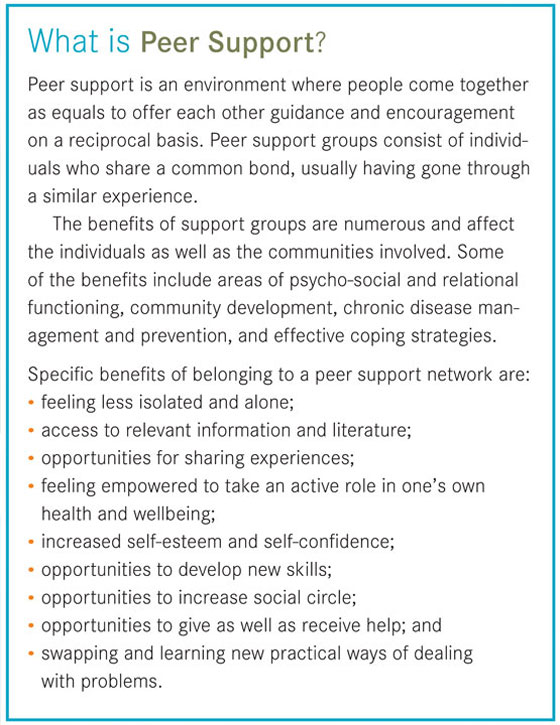Peer support an essential component to recovery
By Ruth Kapelus
A stroke is devastating—not just for the survivor, but also for his or her family members, loved ones and caregivers. Yet with the right support, the journey to recovery can be made easier. Stroke Recovery Canada, a program of March of Dimes Canada, offers post-recovery support, education and programs for stroke survivors, their families and health care providers.
Research and firsthand accounts clearly demonstrate the benefits of support from fellow survivors in helping stroke sufferers regain their independence and confidence. Peer support provides emotional and practical encouragement in a safe environment. Survivors can share their knowledge and experiences, and hopes and concerns—without judgment.
The health care system wants patients to integrate back into the community. Peer support from fellow stroke survivors is a crucial component of community reintegration.
Linking Survivors with Survivors
In 2009, March of Dimes Canada began a pilot program of specialized hospital visits in the Waterloo/Wellington area—Linking Survivors with Survivors.
This program helps to re-engage and reintegrate stroke survivors into the community in partnership with stroke recovery groups in their area. Linking Survivors with Survivors programs are now ongoing in Kitchener-Waterloo, North Wellington, Guelph Wellington, and Cambridge and District, in partnership with the Grand River Hospital and Central South Regional Stroke Network. Today, the program facilitates more than 300 hospital visits a year at six different hospitals and feeds right into the network of community support groups. It is a peer support program that provides hope and encouragement to survivors and their families both in hospital and in the community.
As a result of the successes in the Waterloo-Wellington area, March of Dimes Canada joined with the Toronto Stroke Networks in creating the Transition Improvement for Continuing Care (TICC) initiative. The goal of the TICC is to improve the life experiences of people who have experienced stroke and their caregivers. It has enabled health service providers to come together across sectors to create solutions for more seamless coordinated and integrated care in Toronto.
Peers Fostering Hope
From the TICC, Peers Fostering Hope was born. Peers Fostering Hope received a large bequest from Dr. Ed and Bobby Yielding, which will help continue the program for the next seven years.
Bobby was a stroke survivor, and the family’s very generous gift will help other survivors to thrive in their recovery.
Peers Fostering Hope sends trained volunteers who are stroke survivors to hospitals to speak with people who have recently experienced a stroke and their family or caregivers. The volunteers lend an ear, hold a hand and, most importantly, offer hope. They have been where a new survivor is and they have come through to the other side. The volunteers know firsthand what it means to survive a stroke, and can offer real, tangible hope.
The program seeks to help bridge the gap between the hospital and the community. It is currently underway at Sunnybrook Health Sciences Centre’s Bayview and St. John’s campuses, Humber River Hospital, Toronto Western Hospital, University Health Network, Toronto Rehabilitation Institute and Lakeridge Health Oshawa. West Park, Providence Healthcare and St. Michael’s Hospital will also be implementing the program, and Bridgepoint Health has expressed interest.
 Benefits for everyone
Benefits for everyone
Hospital visits and involvement with peer-support groups help survivors feel more able to age at home and remain active in the community. Volunteers within these two peer-support programs also report that connecting new survivors with a meaningful post-stroke path has positive effects on their own lives. The value of linking survivors with other survivors is evident, both for new and more established stroke survivors who serve as visitors and community volunteers.
You never know what can happen to completely change your life,” says Anna Bauer-Ross. She was a fit, vibrant, 36-year-old mother of two enjoying a vacation in the Bahamas when she was struck by a massive brain-stem stroke.
Airlifted to St. Michael’s in Toronto, Anna spent more than three months in hospital and rehabilitation. She had to regain her ability to see, walk and write. She still has severe left-side neuropathy as a result of her stroke and her vocal chords have never fully healed. Now five years’ post-stroke, Anna lives a full and active life, parenting her teenage girls, attending school with the eventual goal of becoming a social services worker and volunteering with March of Dimes Canada’s Peers Fostering Hope program.
Anna’s placement is at Toronto Western Hospital in the acute care ward. She sees patients who may be only two or three days post-stroke—possibly the most intense time for stroke survivors and their caregivers. Anna is there to let the people she visits know they are not alone, and to answer the many questions from both patients and family members. Although she typically sees a patient only once, being able to provide solace and comfort in the immediacy of a stroke makes her work especially rewarding.
“I would have given anything to have somebody come and talk to me, to share feelings and experiences after my stroke, to have given me a sense of relief,” says Anna. “I like engaging with both survivors and their family members or primary caregivers, and to let them know I’ve been where they are and I’ve come out the other side.”
Anna counsels survivors on the importance of adhering to their medication, staying active and engaged in the community, and remaining motivated in recovery. “I always say that recovery never ends,” she says. “I find there are things I can do now that I couldn’t do six months ago, there are changes every day. Stroke recovery is a journey. There might have bumps and challenges along the way, but there are always improvements.
“Knowing that I am helping people at a time when they most need help, it feels good for me as well,” she continues. “I am grateful to March of Dimes for the opportunity to make this difference for fellow survivors.”
The view from the professionals
Health care providers in the participating hospitals have reported the positive impact the visits have on patients. “I find there is a value added with having these volunteers because the clinicians can see that it relieves some of the patient’s stress,” says a health care provider in an acute care ward.
Staff at the hospitals greet volunteers with a smile because they see how these visits create hope—and, more importantly—improve recovery.
“My hope is that patients leave us feeling a bit more connected or engaged with the stroke survivor community,” says a health care provider working in inpatient rehabilitation. “If they’ve met someone while they’re in the hospital that they can stay in touch with after they go home, or someone that’s hooked them up with Stroke Recovery Canada or March of Dimes, then I think that’s more than I probably could have done on my own.”
Volunteers report how meaningful they find their involvement with Peers Fostering Hope and Linking Survivors with Survivors—and that they wish these programs had been available when they had their stroke. This is proof positive that hospital visits should be an essential best practice for stroke recovery.
Ruth Kapelus works for March of Dimes Canada.
More information about Peers Fostering Hope and Stroke Recovery Canada can be found on the March of Dimes Canada website at www.marchofdimes.ca or by calling 1-800-263-3463.
Special thanks to Jocelyne McKellar, the Rehab & Community Re-engagement Coordinator for the Toronto West Stroke Network for her support with this article.














